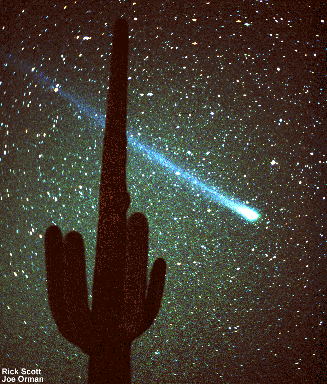Astronomy Picture of the Day
Discover the cosmos!
Each day a different image or photograph of our fascinating universe is
featured, along with a brief explanation written by a professional
astronomer.
May 1, 1996

Comet Hyakutake and a Cactus
Credit:
Rick Scott and Joe Orman,
near Florence Junction, Arizona, Courtesy
Night
of the Comet
Explanation:
Comet Hyakutake is shown photographed the night of March 27 in Arizona,
USA, with a cactus in the foreground.
Polaris, the north star, is the
bright star seen just to the upper right of the comet's head. Today Comet
Hyakutake reaches its closest approach to the
Sun. Comet Hyakutake is now
at its intrinsic brightest, but because of its distance from the
Earth, it
will appear less bright to us than it did during its closest approach to
the Earth in late March. In fact, due to the comet's angular proximity to
the Sun, it will difficult to see at all from the Earth! Comet Hyakutake
will reach less than one quarter of the Earth-Sun distance - inside the
orbit of Mercury.
Comet Hyakutake will
not venture near the Sun again for
another about 15,000 years.
Latest Comet Hyakutake images:
APOD Hyakutake Archive,
JPL,
Fayetteville
Observer-Times,
NASA's Night of
the Comet,
ICSTARS,
Jerry Lodriguss,
ScienceWeb,
Crni Vrh Obs.,
Tomorrow's picture: The Tails of Comet Hyakutake
| Archive
| Index
| Search
| Glossary
| Education
| About APOD |




Authors & editors:
Robert Nemiroff
(GMU) &
Jerry
Bonnell (USRA).
NASA Technical Rep.:
Sherri
Calvo.
Specific rights apply.
A service of:
LHEA
at
NASA/
GSFC




